You're reading the documentation of the v0.9. For the latest released version, please have a look at v1.1.
Circuits
Circuits Overview
The concept of circuit is central in Perceval and the key component of the instrumentalist and the theoretician building a photonic quantum device. Perceval is giving concrete tools to reproduce an optical set-up in an optic laboratory with beams, mirrors and physical component but also photonic chips like a generic interferometer.
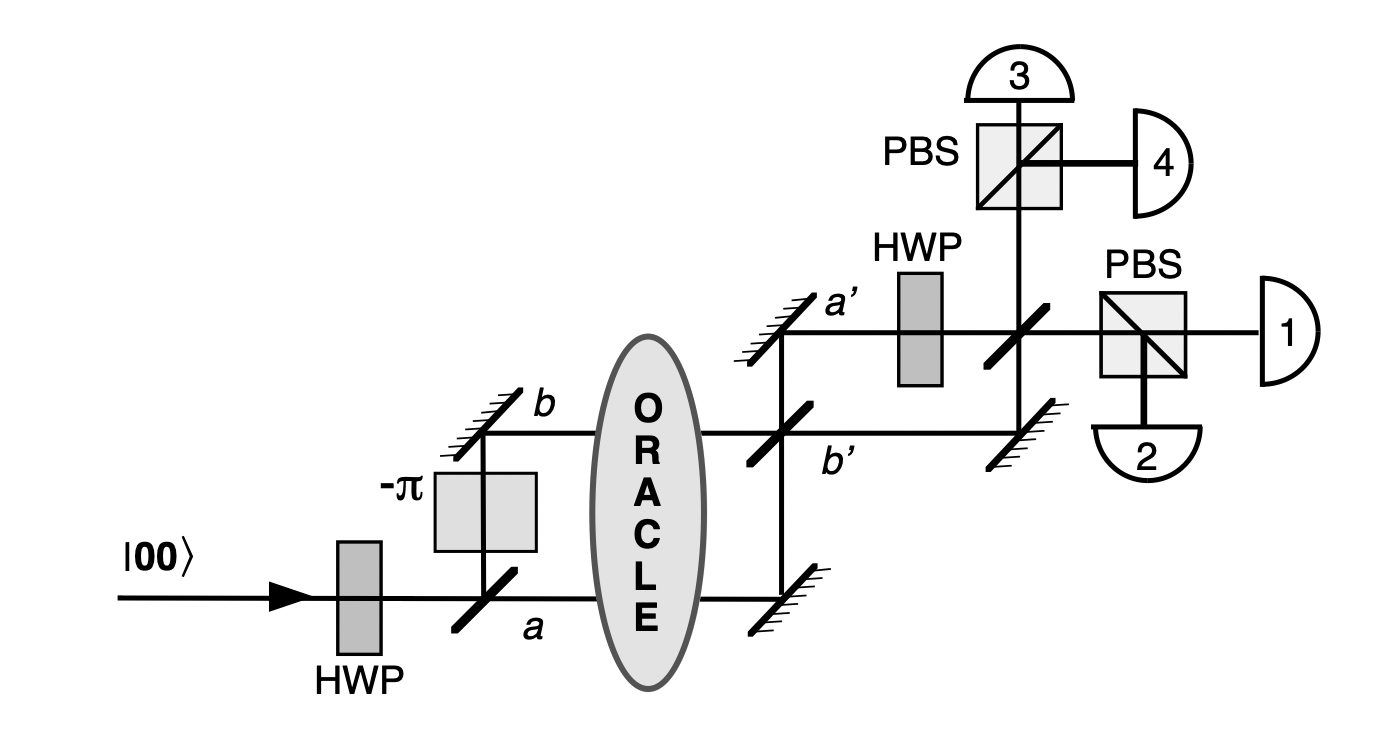
|

The equivalent circuit in Perceval |
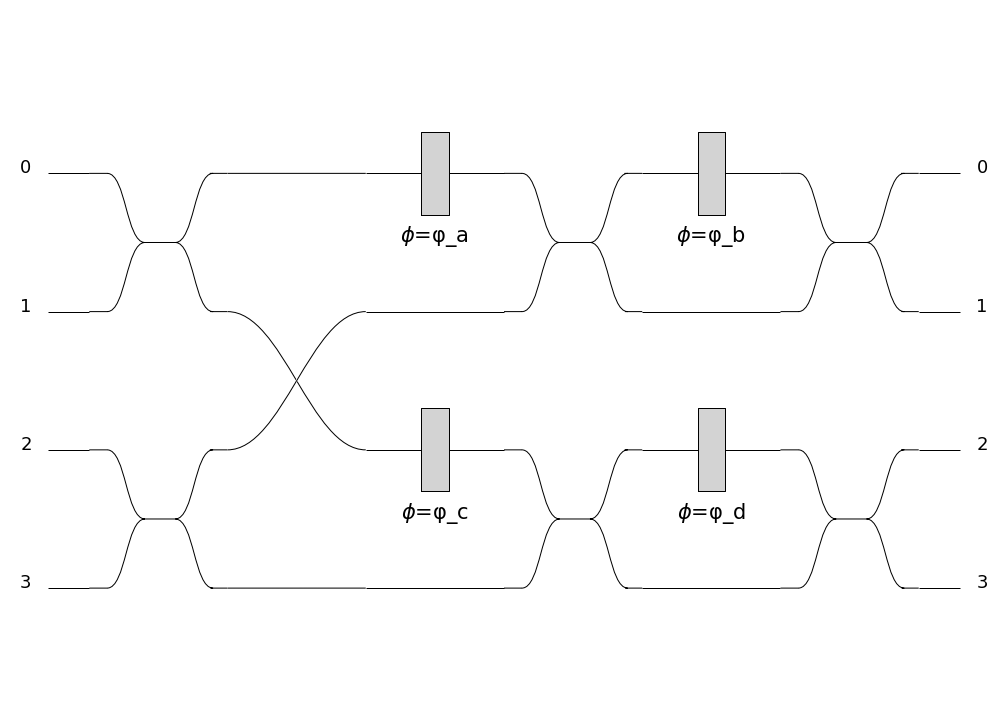
A 4-mode photonic chip (Copyright Quandela 2022) |

The equivalent circuit in Perceval |
What is a Circuit ?
In Perceval a circuit represents a setup of optical components, used to guide and act on photons.
A circuit has a fixed number of spatial modes (sometimes also called paths or ports) \(m\), which is the same for input as for output spatial modes.
Simple examples of circuits are common optical devices such as beam splitters, phase shifters, or wave plates. Perceval provides a collection of these (see Components).

A beam splitter as a circuit in Perceval.
In particular, note that:
sources aren’t circuits, since they do not have input spatial modes (they don’t guide or act on incoming photons, but produce photons that are sent into a circuit),
detectors aren’t circuits either, for similar reasons
Warning
An optical circuit (just called “circuit” here) isn’t the same as a quantum circuit. Quantum circuits act on qubits, i.e. abstract systems in a 2-dimentional Hilbert space; while optical circuits act on photons distributed in spatial modes. It is possible to simply encode qubits with photons in an optical circuit; some encodings are presented in the Basics section.
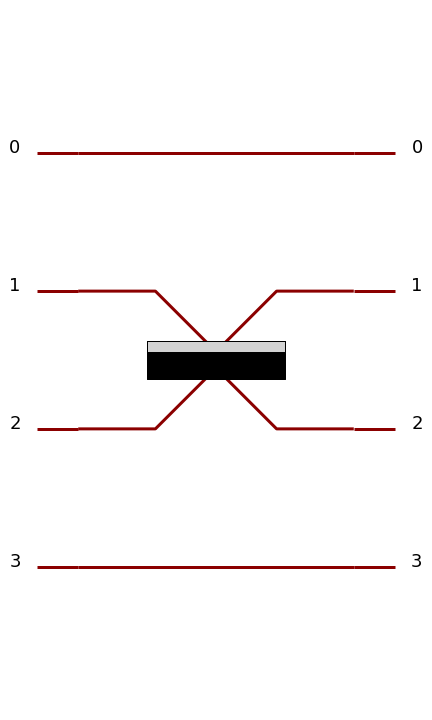
A simple circuit with 4 spatial modes, containing a beam splitter (being itself a circuit) between second and third spatial modes
Circuits can be combined together and used as building blocks to construct larger circuits. In the example above, a beam splitter, which is a builtin circuit with 2 spatial modes, has been used in a larger circuit with 4 spatial modes.
The lines, corresponding to spatial modes, are representing optical fibers on which photons are sent from the left to the right.
Building a Circuit
Each circuit corresponds to a Circuit object.
To instantiate a circuit, simply pass the number of modes as an argument:
>>> # create a new circuit with 3 spatial modes
>>> my_circuit = pcvl.Circuit(3)
Warning
Ports are using 0-based numbering - so port 0 is corresponding to the first line, … port \((m-1)\) is corresponding to the \(m\)-th line.
Circuit library
Perceval provides a library of predefined components, located in perceval.components:
>>> import perceval.components as comp
This library contain simple circuits stored in a few sub-packages. For instance:
unitary_componentsprovides circuits which can be represented by a unitary matrix.non_unitary_componentsprovides other types of circuit, such as time delays.
Circuit Rendering
Perceval provides pdisplay function as an easy and ergonomic way to display a lot of Perceval objects, given the
execution context (Jupyter notebook, IDE, command line script). Circuit rendering is built upon a skin system allowing
to style your output image.
Perceval comes with two built-in skins:
SymbSkin: a sober black and white skinPhysSkin: a more colorful “real-life” skin
The following figure shows the same Mach Zehnder Interferometer circuit represented with the SymbSkin on the left
and the PhysSkin on the right:

>>> from perceval.rendering.circuit import SymbSkin, PhysSkin
>>> perceval.pdisplay(circuit, skin=SymbSkin())
See Components for an overview of the circuits provided by Perceval.
In addition to the generic properties of complex circuits, elementary circuits also have the following features:
Definition:
definition()method gives the definition of the circuit - allowing to know in particular, the parameters to use and the way the unitary matrix is computed.>>> pcvl.pdisplay(comp.BS().definition()) ⎡cos(theta) I*exp(-I*phi)*sin(theta)⎤ ⎣I*exp(I*phi)*sin(theta) cos(theta) ⎦
Parameterization: most of the elementary circuits are defined by parameters. For instance a phase shifter will take the phase \(\phi\) as a parameter. You can either initialize these parameters with a fixed numeric value:
comp.PS(1.57), with a symbolic valuecomp.PS(sp.pi/2)or with a non fixed parameter:comp.PS(pcvl.P("alpha")). See Parameters for more information.
Defining circuits from a unitary matrix
You can also define any circuit directly from a unitary matrix. In
Perceval a unitary matrix corresponds to a Matrix object, which
can simply created from a list matrix. The code:
>>> M = pcvl.Matrix([[0, 0, 1],
... [0, 1, 0],
... [1, 0, 0]])
corresponds to the unitary matrix: \(\left[\begin{matrix}0 & 0 & 1\\0 & 1 & 0\\1 & 0 & 0\end{matrix}\right]\)
The following then defines a circuit corresponding to this matrix:
>>> c1 = comp.Unitary(U=M)
You might also want to decompose the unitary matrix into a physical circuit using decomposition elements. Let us define for instance:
>>> ub = Circuit(2, name="ub") // comp.BS() // (0, comp.PS(phi=pcvl.Parameter("φ_a"))) // comp.BS() // (1, comp.PS(phi=pcvl.Parameter("φ_b")))
Then you can build a circuit using the method perceval.components.circuit.Circuit.decomposition():
>>> c2 = pcvl.Circuit.decomposition(M, mzi, shape="triangle")
>>> c2.describe()
Circuit(3).add((0, 1), phys.BS()).add(0, phys.PS(phi=pi)).add((0, 1), phys.BS()).add(1, phys.PS(phi=0.681255)).add((1, 2), phys.BS()).add(1, phys.PS(phi=-pi)).add((1, 2), phys.BS()).add(2, phys.PS(phi=0.124498)).add((0, 1), phys.BS()).add(0, phys.PS(phi=pi)).add((0, 1), phys.BS()).add(1, phys.PS(phi=3.974189))
>>> pcvl.pdisplay(c2)

Some additional parameters can simplifiy the decomposition:
permutation: if set to a permutation component, permutations will be used when possible instead of a unitary block
>>> import perceval as pcvl
>>> import perceval.components.unitary_components as comp
>>> C1 = pcvl.Circuit.decomposition(comp.PERM([3, 2, 1, 0]).compute_unitary(False),
>>> comp.BS(theta=pcvl.Parameter("theta")),
>>> permutation=comp.PERM,
>>> shape="triangle")
>>>pcvl.pdisplay(C1)
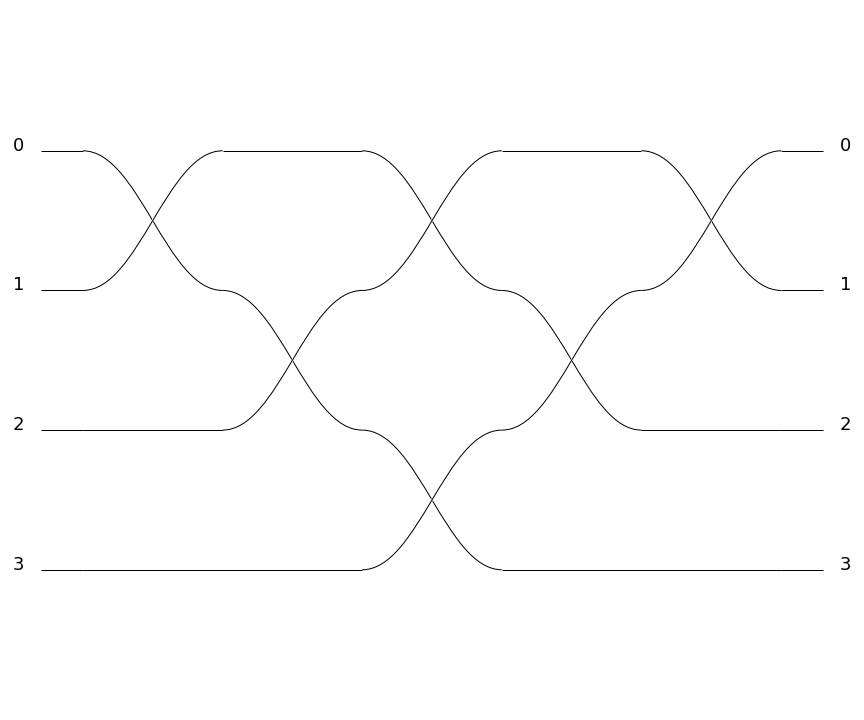
constraints: you can provide a list of constraints on the different parameters of the unitary blocks to try to find circuits with constrained parameters. Each constraint is a t-uple of None or numerical value. When decomposing the circuit, the parameters will be searched iteratively in the constrained spaces. For instance: [(0, None), (np.pi/2, None), (None, None)] will allow to look for parameters pairs where the first parameter is 0 or \(pi/2\), or any value if no solution is found with the first constraints.
>>> U=1/3*np.array([[np.sqrt(3),-np.sqrt(6)*1j,0,0,0,0],
>>> [-np.sqrt(6)*1j,np.sqrt(3),0,0,0,0],
>>> [0,0,np.sqrt(3),-np.sqrt(3)*1j,-np.sqrt(3)*1j,0],
>>> [0,0,-np.sqrt(3)*1j,np.sqrt(3),0,np.sqrt(3)],
>>> [0,0,-np.sqrt(3)*1j,0,np.sqrt(3),-np.sqrt(3)],
>>> [0,0,0,np.sqrt(3),-np.sqrt(3),-np.sqrt(3)]])
>>> ub = comp.BS(theta=pcvl.P("theta")) // comp.PS(phi=pcvl.P("phi"))
>>> C1 = pcvl.Circuit.decomposition(U,
>>> ub,
>>> shape="triangle", constraints=[(None,0),(None,np.pi/2),
>>> (None,3*np.pi/2),(None,None)])
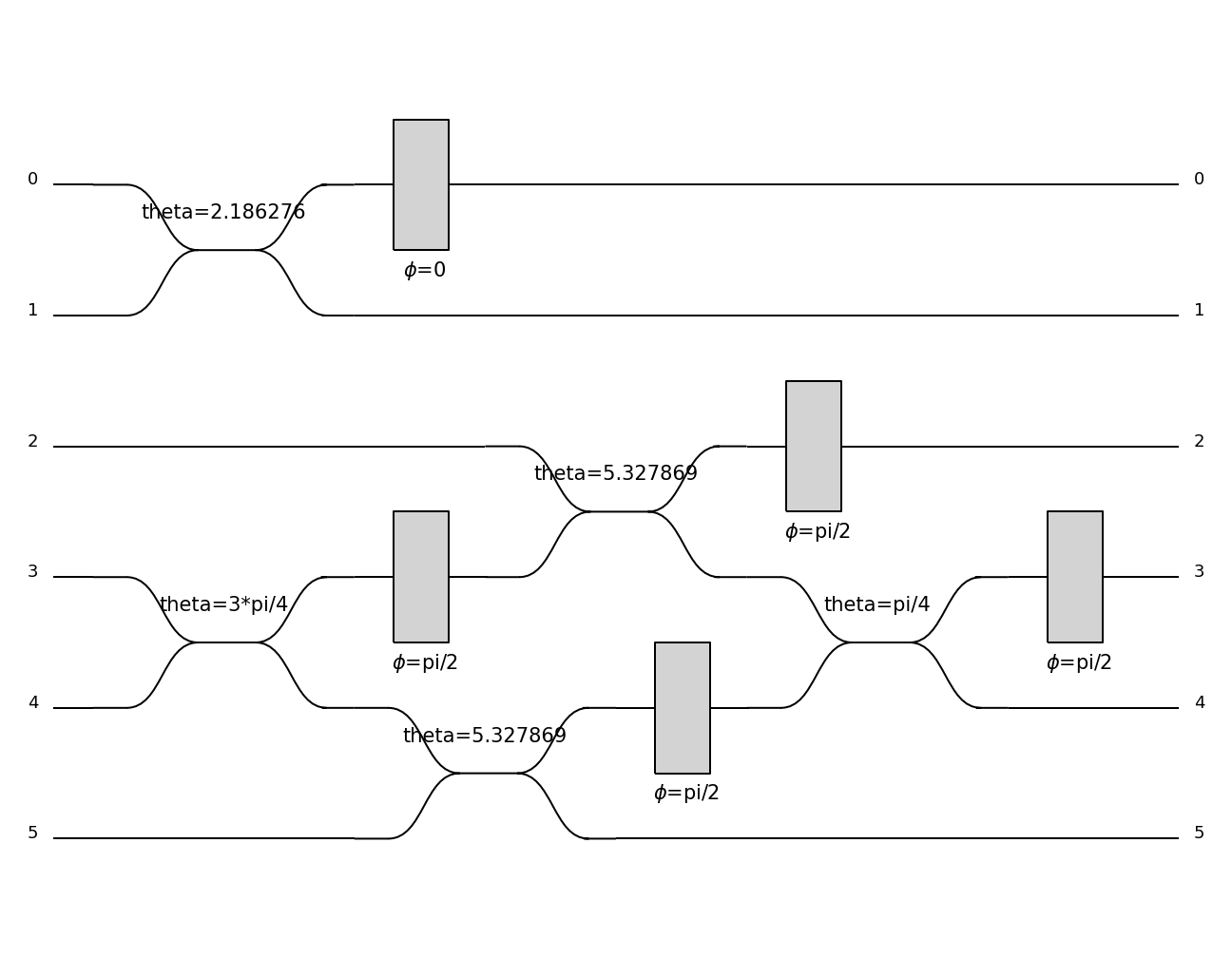
phase_shifter_fn: if you provide a phase-shifter to this parameter, the decomposition will add a layer of phases making the decomposed circuit strictly equivalent to the initial unitary matrix. In most cases, you can however omit this layer.
finally, you can also pass simpler unitary blocks - for instance a simple beamsplitter without phase, however in these cases, you might not obtain any solution in the decomposition
Accessing components in a circuit
It is possible to access directly a component from a circuit using row and column indices - note that a same component may have different column indices for the different rows it spans over:
>>> c = Circuit(2) // comp.BS.H() // comp.PS(P("phi1")) // comp.BS.Rx() // comp.PS(P("phi2"))
>>> print (c[1, 1].describe())
BS(convention=BSConvention.Rx)
>>> print (c[0, 2].describe())
BS(convention=BSConvention.Rx)
Circuit simplification
The syntax is the following:
>>> from perceval.utils.algorithms.simplification import simplify
>>>
>>> c = Circuit() // ...
>>> simplified_c = simplify(c, display = False)
Circuit simplification takes a circuit and does the following:
For phase shifters, add their phase if they are not parameters and combine them into a single phase shifters (work through permutations). If
display == False, removes them if their added phase is \(0\) or \(2\pi\).For Permutations, if two permutations are consecutive, they are combined into a single permutation. For single permutations, fixed modes at the extremities are removed. If they are not just consecutive, try to compute a “better” permutation, then if it is better, moves the components accordingly to this new permutation. Display changes how a permutation is evaluated.
Complex Circuits
Assembling circuits
A circuit is defined by using Circuit object as following:
>>> c = pcvl.Circuit(m)
Where m is the number of modes of the circuit. See Circuit for additional parameters.
Then components of the circuit are added with the add primitive:
>>> c.add((0, 1), comp.BS())
Where:
The first parameter is either the port range (here ports 0 and 1), or the upper where the component should be added. The previous declaration is equivalent to:
>>> c.add(0, comp.BS())
The second parameter is a circuit, it can be an elementary circuit as in our example, or another complex circuit.
Tip
It is possible to add multiple components in a single statement allowing for simpler circuit declaration:
>>> mzi = pcvl.Circuit(2).add(0, comp.BS()).add(0, comp.PS(pcvl.Parameter("phi1")))\
... .add(0, comp.BS()).add(0, comp.PS(pcvl.Parameter("phi2"))))
alternatively, you can also use // notation for more compact definition, and start from unitary circuit:
>>> mzi = comp.BS() // (0, comp.PS(pcvl.Parameter("phi1"))) // comp.BS() // (0, comp.PS(pcvl.Parameter("phi2")))
Generic Interferometer
It is also possible to define generic interferometers with the static method
perceval.components.circuit.Circuit.generic_interferometer().
For instance the following defines a triangular interferometer on 8 modes using a beam splitter and a phase shifter as base components:
>>> c = pcvl.Circuit.generic_interferometer(8,
... lambda i: comp.BS() // comp.PS(pcvl.P("φ%d" % i)),
... shape="triangle")
>>> pcvl.pdisplay(c)

Sub-circuits
When you assemble to build a circuit, you can naturally include a complex circuit into another one:
>>> bsps = comp.BS().add(0, comp.PS(sp.pi/2))
>>> c = pcvl.Circuit(3).add(0, bsps).add(1, bsps)
>>> pcvl.pdisplay(c)
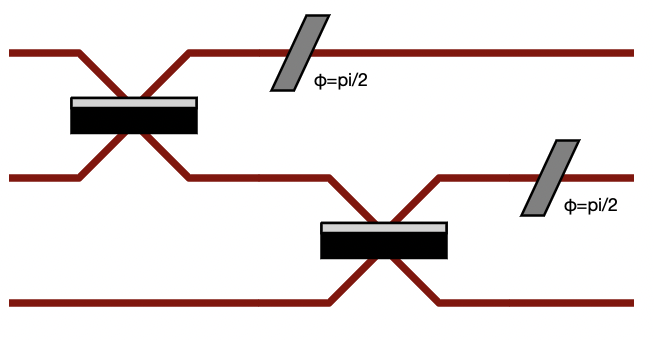
By default, the new circuits merge all the circuits into a single one by using merge=False parameter:
>>> c = pcvl.Circuit(3).add(0, bsps).add(1, bsps, merge=False)
>>> pcvl.pdisplay(c)
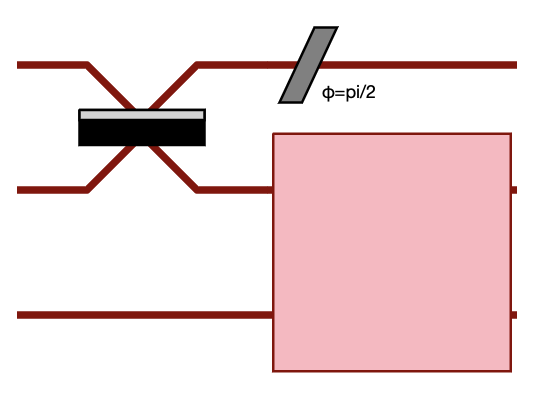
This can be particularly useful to get a better visual organization of large circuit.
Unitary Matrices
Except for circuits using Time Delay, any circuit can be converted into its unitary matrix. Depending if your circuit is using Parameters or not, the unitary matrix will be symbolic or numeric.
>>> chip4mode = pcvl.Circuit(m=4, name="QChip")
>>> phis = [pcvl.Parameter("phi1"), pcvl.Parameter("phi2"),
... pcvl.Parameter("phi3"), pcvl.Parameter("phi4")]
>>> (chip4mode
... .add((0, 1), comp.BS()).add((2, 3), comp.BS()).add((1, 2), comp.PERM([1, 0]))
... .add(0, comp.PS(phis[0])).add(2, comp.PS(phis[2])).add((0, 1), comp.BS())
... .add((2, 3), comp.BS()).add(0, comp.PS(phis[1])).add(2, comp.PS(phis[3]))
... .add((0, 1), comp.BS()).add((2, 3), comp.BS()))
>>> pcvl.pdisplay(chip4mode.U)
\(\left[\begin{matrix}\frac{\sqrt{2} \left(- e^{i \phi_{1}} + e^{i \left(\phi_{1} + \phi_{2}\right)}\right)}{4} & \frac{\sqrt{2} i \left(- e^{i \phi_{1}} + e^{i \left(\phi_{1} + \phi_{2}\right)}\right)}{4} & \frac{\sqrt{2} i \left(e^{i \phi_{2}} + 1\right)}{4} & - \frac{\sqrt{2} \left(e^{i \phi_{2}} + 1\right)}{4}\\\frac{\sqrt{2} i \left(e^{i \phi_{1}} + e^{i \left(\phi_{1} + \phi_{2}\right)}\right)}{4} & - \frac{\sqrt{2} \left(e^{i \phi_{1}} + e^{i \left(\phi_{1} + \phi_{2}\right)}\right)}{4} & \frac{\sqrt{2} \left(1 - e^{i \phi_{2}}\right)}{4} & \frac{\sqrt{2} i \left(1 - e^{i \phi_{2}}\right)}{4}\\\frac{\sqrt{2} i \left(- e^{i \phi_{3}} + e^{i \left(\phi_{3} + \phi_{4}\right)}\right)}{4} & \frac{\sqrt{2} \left(- e^{i \phi_{3}} + e^{i \left(\phi_{3} + \phi_{4}\right)}\right)}{4} & - \frac{\sqrt{2} \left(e^{i \phi_{4}} + 1\right)}{4} & \frac{\sqrt{2} i \left(e^{i \phi_{4}} + 1\right)}{4}\\- \frac{\sqrt{2} \left(e^{i \phi_{3}} + e^{i \left(\phi_{3} + \phi_{4}\right)}\right)}{4} & \frac{\sqrt{2} i \left(e^{i \phi_{3}} + e^{i \left(\phi_{3} + \phi_{4}\right)}\right)}{4} & \frac{\sqrt{2} i \left(1 - e^{i \phi_{4}}\right)}{4} & \frac{\sqrt{2} \left(1 - e^{i \phi_{4}}\right)}{4}\end{matrix}\right]\)
See perceval.components.circuit.Circuit.compute_unitary() for more information.
Circuit Rewriting
To enable circuit rewriting operations introduced in [20], the following methods are available for matching a specific pattern in a circuit, and to replace the corresponding sub-circuit by an equivalent circuit.
The complete sequence is the following:
>>> while True:
... # identify one instance of the parameterized "pattern" within a circuit
... matched = circuit.match(pattern, browse=True)
... # check if an occurence was found
... if matched is None:
... break
... # transform the list of matched components into a sub-circuit
... idx = a.isolate(list(matched.pos_map.keys()))
... # check if an equivalent "rewrite" circuit can be found
... res = optimize(rewrite, v, frobenius, sign=-1)
... # check if we can rewrite this pattern closely enough to original circuit, here with frobenius distance
... if res.fun > 1e-6:
... break
... # replace the subcircuit by a copy of the pattern
... a.replace(idx, rewrite.copy(), merge=True)
... # reset all parameters of pattern and rewrite circuit that have been instantiated by
... # the matching/optimize process
... pattern.reset_parameters()
... rewrite.reset_parameters()
See Reference to Notebook for a complete functional example.